Gender Mainstreaming and its Impact on Socio-Economic Goals Globally
VerifiedAdded on 2023/06/10
|20
|5317
|50
Essay
AI Summary
This essay delves into the multifaceted aspects of gender mainstreaming within the context of world politics. It examines the concept's evolution, its relevance to international relations, and its influence on socio-economic goals. The discussion encompasses various policies, treaties, and the institutional and discursive perspectives that shape gender mainstreaming. The essay further identifies the advantages, such as promoting gender equality and fostering inclusive policy development, and disadvantages, including potential tokenism and challenges in implementation. By analyzing these pros and cons, the essay provides a comprehensive overview of how gender mainstreaming can enhance global lives and contribute to a more equitable world, emphasizing the importance of addressing gender inequality in political power, household dynamics, and legal entitlements.
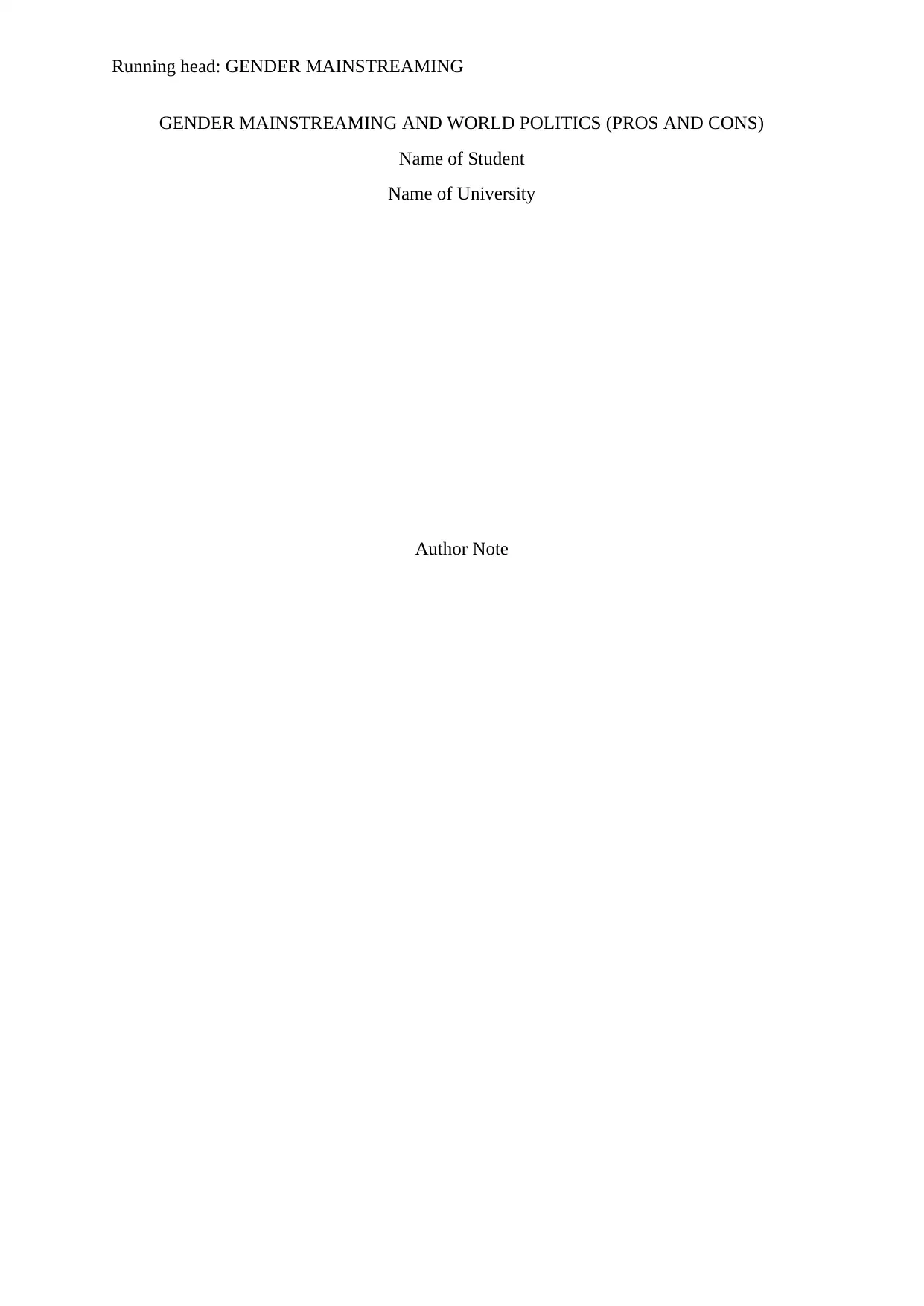
Running head: GENDER MAINSTREAMING
GENDER MAINSTREAMING AND WORLD POLITICS (PROS AND CONS)
Name of Student
Name of University
Author Note
GENDER MAINSTREAMING AND WORLD POLITICS (PROS AND CONS)
Name of Student
Name of University
Author Note
Paraphrase This Document
Need a fresh take? Get an instant paraphrase of this document with our AI Paraphraser
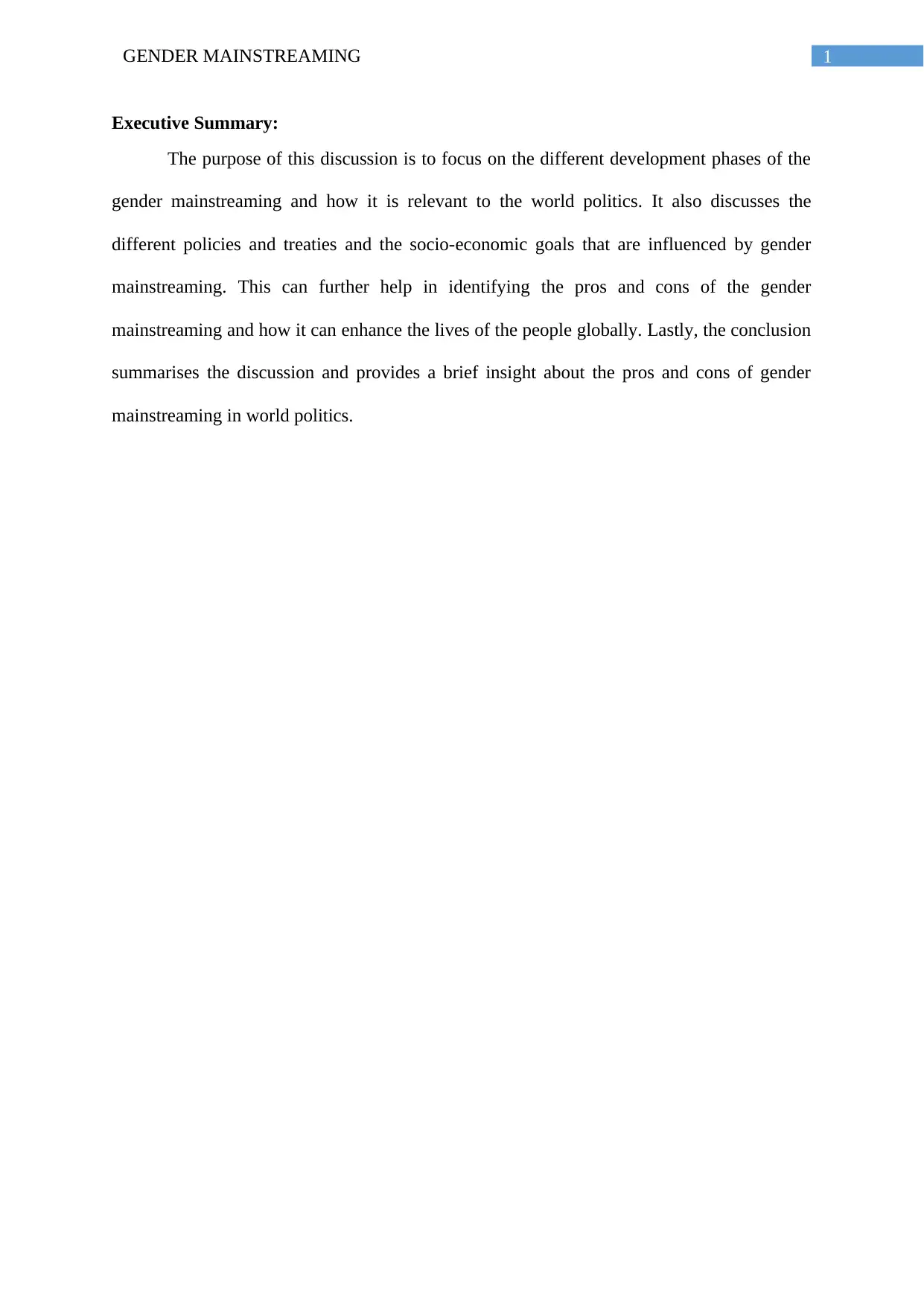
1GENDER MAINSTREAMING
Executive Summary:
The purpose of this discussion is to focus on the different development phases of the
gender mainstreaming and how it is relevant to the world politics. It also discusses the
different policies and treaties and the socio-economic goals that are influenced by gender
mainstreaming. This can further help in identifying the pros and cons of the gender
mainstreaming and how it can enhance the lives of the people globally. Lastly, the conclusion
summarises the discussion and provides a brief insight about the pros and cons of gender
mainstreaming in world politics.
Executive Summary:
The purpose of this discussion is to focus on the different development phases of the
gender mainstreaming and how it is relevant to the world politics. It also discusses the
different policies and treaties and the socio-economic goals that are influenced by gender
mainstreaming. This can further help in identifying the pros and cons of the gender
mainstreaming and how it can enhance the lives of the people globally. Lastly, the conclusion
summarises the discussion and provides a brief insight about the pros and cons of gender
mainstreaming in world politics.
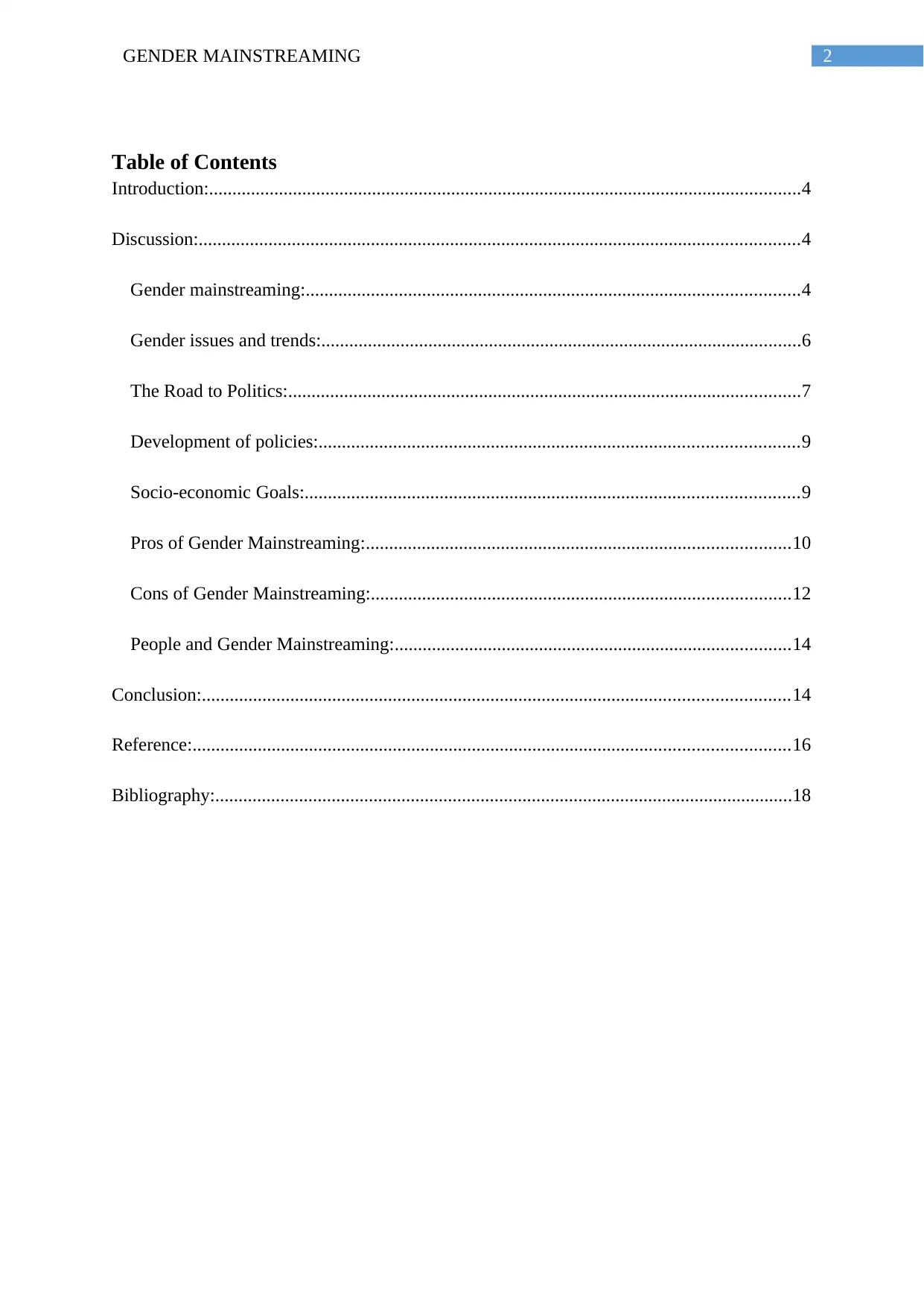
2GENDER MAINSTREAMING
Table of Contents
Introduction:...............................................................................................................................4
Discussion:.................................................................................................................................4
Gender mainstreaming:..........................................................................................................4
Gender issues and trends:.......................................................................................................6
The Road to Politics:..............................................................................................................7
Development of policies:.......................................................................................................9
Socio-economic Goals:..........................................................................................................9
Pros of Gender Mainstreaming:...........................................................................................10
Cons of Gender Mainstreaming:..........................................................................................12
People and Gender Mainstreaming:.....................................................................................14
Conclusion:..............................................................................................................................14
Reference:................................................................................................................................16
Bibliography:............................................................................................................................18
Table of Contents
Introduction:...............................................................................................................................4
Discussion:.................................................................................................................................4
Gender mainstreaming:..........................................................................................................4
Gender issues and trends:.......................................................................................................6
The Road to Politics:..............................................................................................................7
Development of policies:.......................................................................................................9
Socio-economic Goals:..........................................................................................................9
Pros of Gender Mainstreaming:...........................................................................................10
Cons of Gender Mainstreaming:..........................................................................................12
People and Gender Mainstreaming:.....................................................................................14
Conclusion:..............................................................................................................................14
Reference:................................................................................................................................16
Bibliography:............................................................................................................................18
⊘ This is a preview!⊘
Do you want full access?
Subscribe today to unlock all pages.

Trusted by 1+ million students worldwide
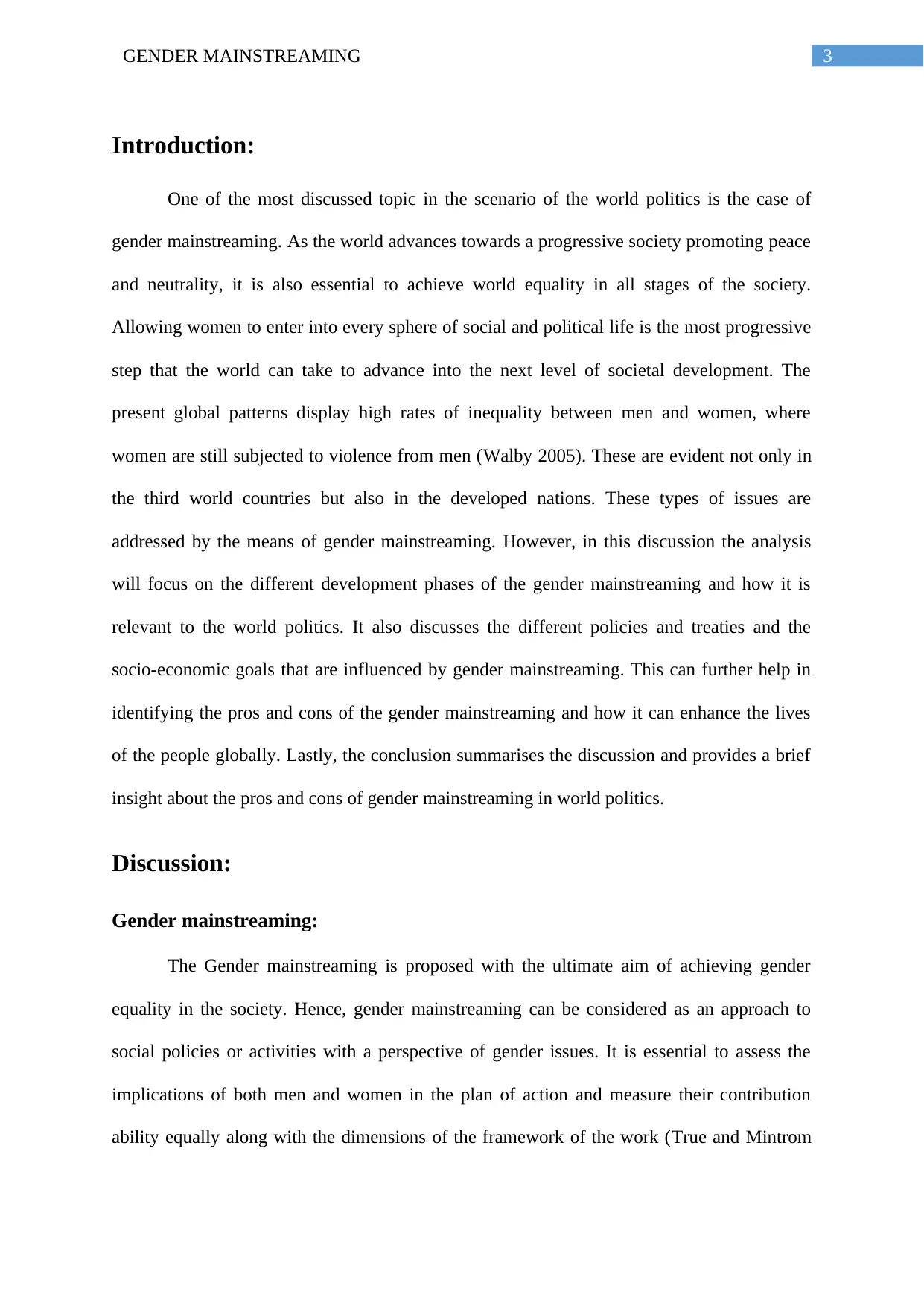
3GENDER MAINSTREAMING
Introduction:
One of the most discussed topic in the scenario of the world politics is the case of
gender mainstreaming. As the world advances towards a progressive society promoting peace
and neutrality, it is also essential to achieve world equality in all stages of the society.
Allowing women to enter into every sphere of social and political life is the most progressive
step that the world can take to advance into the next level of societal development. The
present global patterns display high rates of inequality between men and women, where
women are still subjected to violence from men (Walby 2005). These are evident not only in
the third world countries but also in the developed nations. These types of issues are
addressed by the means of gender mainstreaming. However, in this discussion the analysis
will focus on the different development phases of the gender mainstreaming and how it is
relevant to the world politics. It also discusses the different policies and treaties and the
socio-economic goals that are influenced by gender mainstreaming. This can further help in
identifying the pros and cons of the gender mainstreaming and how it can enhance the lives
of the people globally. Lastly, the conclusion summarises the discussion and provides a brief
insight about the pros and cons of gender mainstreaming in world politics.
Discussion:
Gender mainstreaming:
The Gender mainstreaming is proposed with the ultimate aim of achieving gender
equality in the society. Hence, gender mainstreaming can be considered as an approach to
social policies or activities with a perspective of gender issues. It is essential to assess the
implications of both men and women in the plan of action and measure their contribution
ability equally along with the dimensions of the framework of the work (True and Mintrom
Introduction:
One of the most discussed topic in the scenario of the world politics is the case of
gender mainstreaming. As the world advances towards a progressive society promoting peace
and neutrality, it is also essential to achieve world equality in all stages of the society.
Allowing women to enter into every sphere of social and political life is the most progressive
step that the world can take to advance into the next level of societal development. The
present global patterns display high rates of inequality between men and women, where
women are still subjected to violence from men (Walby 2005). These are evident not only in
the third world countries but also in the developed nations. These types of issues are
addressed by the means of gender mainstreaming. However, in this discussion the analysis
will focus on the different development phases of the gender mainstreaming and how it is
relevant to the world politics. It also discusses the different policies and treaties and the
socio-economic goals that are influenced by gender mainstreaming. This can further help in
identifying the pros and cons of the gender mainstreaming and how it can enhance the lives
of the people globally. Lastly, the conclusion summarises the discussion and provides a brief
insight about the pros and cons of gender mainstreaming in world politics.
Discussion:
Gender mainstreaming:
The Gender mainstreaming is proposed with the ultimate aim of achieving gender
equality in the society. Hence, gender mainstreaming can be considered as an approach to
social policies or activities with a perspective of gender issues. It is essential to assess the
implications of both men and women in the plan of action and measure their contribution
ability equally along with the dimensions of the framework of the work (True and Mintrom
Paraphrase This Document
Need a fresh take? Get an instant paraphrase of this document with our AI Paraphraser
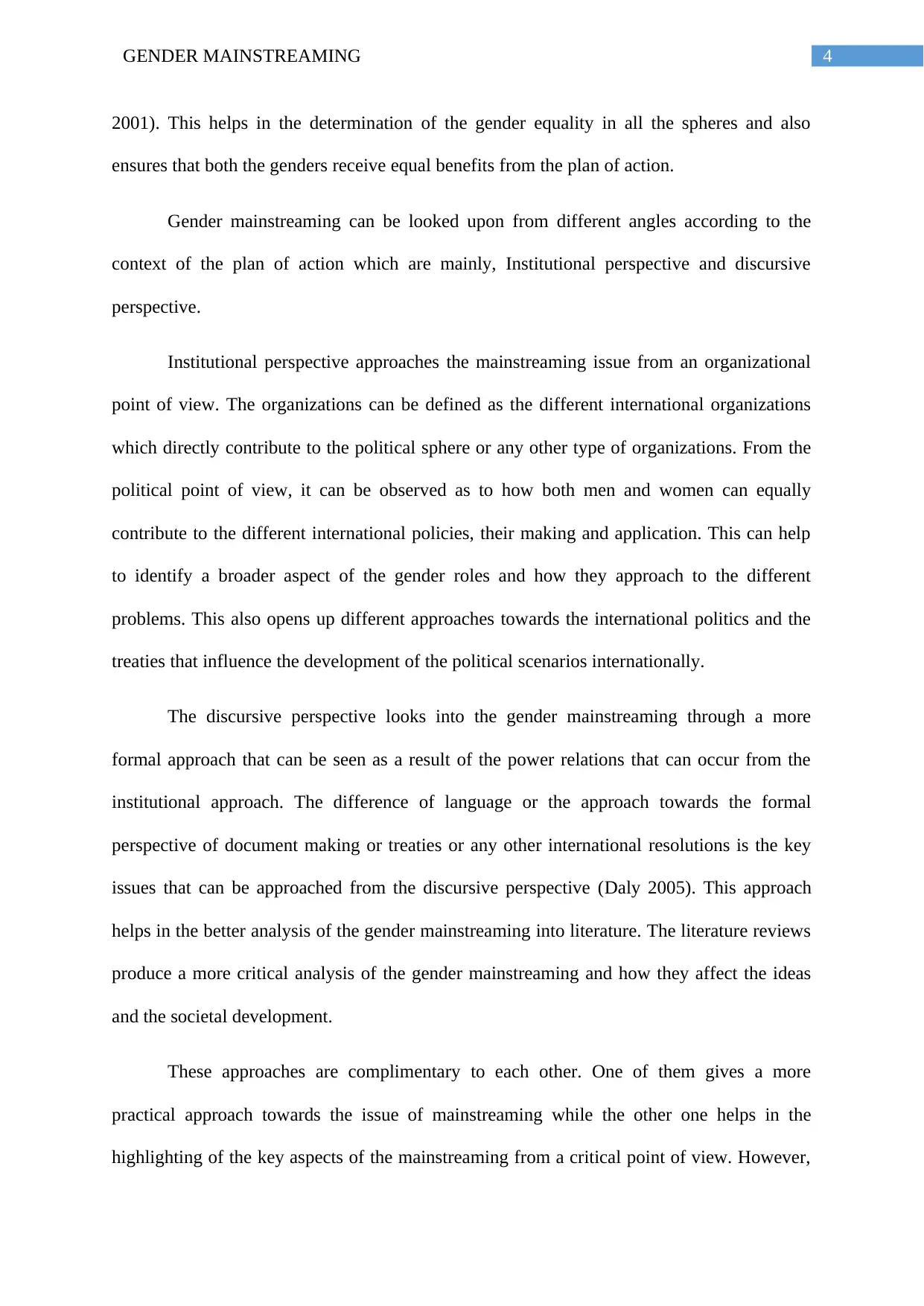
4GENDER MAINSTREAMING
2001). This helps in the determination of the gender equality in all the spheres and also
ensures that both the genders receive equal benefits from the plan of action.
Gender mainstreaming can be looked upon from different angles according to the
context of the plan of action which are mainly, Institutional perspective and discursive
perspective.
Institutional perspective approaches the mainstreaming issue from an organizational
point of view. The organizations can be defined as the different international organizations
which directly contribute to the political sphere or any other type of organizations. From the
political point of view, it can be observed as to how both men and women can equally
contribute to the different international policies, their making and application. This can help
to identify a broader aspect of the gender roles and how they approach to the different
problems. This also opens up different approaches towards the international politics and the
treaties that influence the development of the political scenarios internationally.
The discursive perspective looks into the gender mainstreaming through a more
formal approach that can be seen as a result of the power relations that can occur from the
institutional approach. The difference of language or the approach towards the formal
perspective of document making or treaties or any other international resolutions is the key
issues that can be approached from the discursive perspective (Daly 2005). This approach
helps in the better analysis of the gender mainstreaming into literature. The literature reviews
produce a more critical analysis of the gender mainstreaming and how they affect the ideas
and the societal development.
These approaches are complimentary to each other. One of them gives a more
practical approach towards the issue of mainstreaming while the other one helps in the
highlighting of the key aspects of the mainstreaming from a critical point of view. However,
2001). This helps in the determination of the gender equality in all the spheres and also
ensures that both the genders receive equal benefits from the plan of action.
Gender mainstreaming can be looked upon from different angles according to the
context of the plan of action which are mainly, Institutional perspective and discursive
perspective.
Institutional perspective approaches the mainstreaming issue from an organizational
point of view. The organizations can be defined as the different international organizations
which directly contribute to the political sphere or any other type of organizations. From the
political point of view, it can be observed as to how both men and women can equally
contribute to the different international policies, their making and application. This can help
to identify a broader aspect of the gender roles and how they approach to the different
problems. This also opens up different approaches towards the international politics and the
treaties that influence the development of the political scenarios internationally.
The discursive perspective looks into the gender mainstreaming through a more
formal approach that can be seen as a result of the power relations that can occur from the
institutional approach. The difference of language or the approach towards the formal
perspective of document making or treaties or any other international resolutions is the key
issues that can be approached from the discursive perspective (Daly 2005). This approach
helps in the better analysis of the gender mainstreaming into literature. The literature reviews
produce a more critical analysis of the gender mainstreaming and how they affect the ideas
and the societal development.
These approaches are complimentary to each other. One of them gives a more
practical approach towards the issue of mainstreaming while the other one helps in the
highlighting of the key aspects of the mainstreaming from a critical point of view. However,
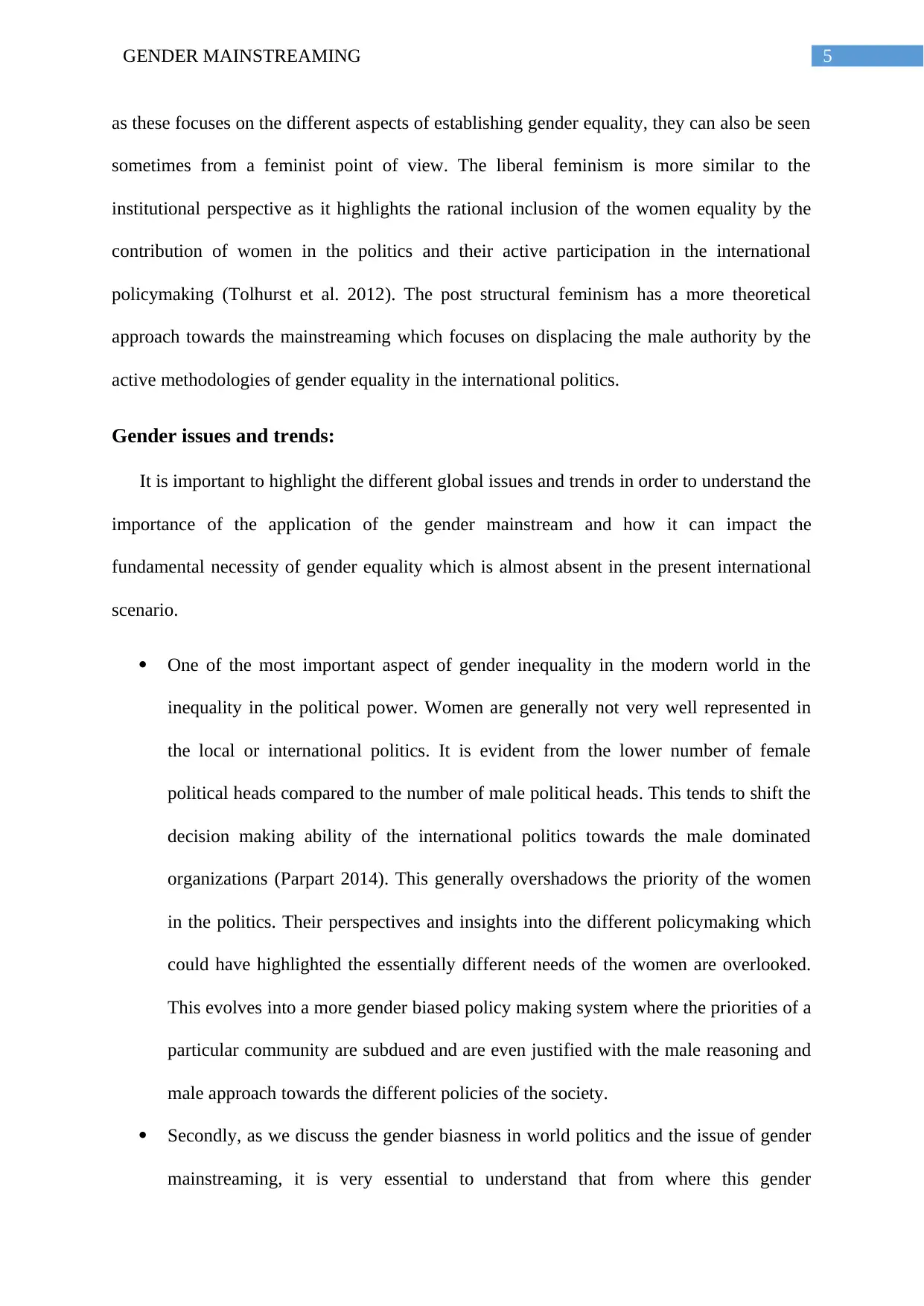
5GENDER MAINSTREAMING
as these focuses on the different aspects of establishing gender equality, they can also be seen
sometimes from a feminist point of view. The liberal feminism is more similar to the
institutional perspective as it highlights the rational inclusion of the women equality by the
contribution of women in the politics and their active participation in the international
policymaking (Tolhurst et al. 2012). The post structural feminism has a more theoretical
approach towards the mainstreaming which focuses on displacing the male authority by the
active methodologies of gender equality in the international politics.
Gender issues and trends:
It is important to highlight the different global issues and trends in order to understand the
importance of the application of the gender mainstream and how it can impact the
fundamental necessity of gender equality which is almost absent in the present international
scenario.
One of the most important aspect of gender inequality in the modern world in the
inequality in the political power. Women are generally not very well represented in
the local or international politics. It is evident from the lower number of female
political heads compared to the number of male political heads. This tends to shift the
decision making ability of the international politics towards the male dominated
organizations (Parpart 2014). This generally overshadows the priority of the women
in the politics. Their perspectives and insights into the different policymaking which
could have highlighted the essentially different needs of the women are overlooked.
This evolves into a more gender biased policy making system where the priorities of a
particular community are subdued and are even justified with the male reasoning and
male approach towards the different policies of the society.
Secondly, as we discuss the gender biasness in world politics and the issue of gender
mainstreaming, it is very essential to understand that from where this gender
as these focuses on the different aspects of establishing gender equality, they can also be seen
sometimes from a feminist point of view. The liberal feminism is more similar to the
institutional perspective as it highlights the rational inclusion of the women equality by the
contribution of women in the politics and their active participation in the international
policymaking (Tolhurst et al. 2012). The post structural feminism has a more theoretical
approach towards the mainstreaming which focuses on displacing the male authority by the
active methodologies of gender equality in the international politics.
Gender issues and trends:
It is important to highlight the different global issues and trends in order to understand the
importance of the application of the gender mainstream and how it can impact the
fundamental necessity of gender equality which is almost absent in the present international
scenario.
One of the most important aspect of gender inequality in the modern world in the
inequality in the political power. Women are generally not very well represented in
the local or international politics. It is evident from the lower number of female
political heads compared to the number of male political heads. This tends to shift the
decision making ability of the international politics towards the male dominated
organizations (Parpart 2014). This generally overshadows the priority of the women
in the politics. Their perspectives and insights into the different policymaking which
could have highlighted the essentially different needs of the women are overlooked.
This evolves into a more gender biased policy making system where the priorities of a
particular community are subdued and are even justified with the male reasoning and
male approach towards the different policies of the society.
Secondly, as we discuss the gender biasness in world politics and the issue of gender
mainstreaming, it is very essential to understand that from where this gender
⊘ This is a preview!⊘
Do you want full access?
Subscribe today to unlock all pages.

Trusted by 1+ million students worldwide
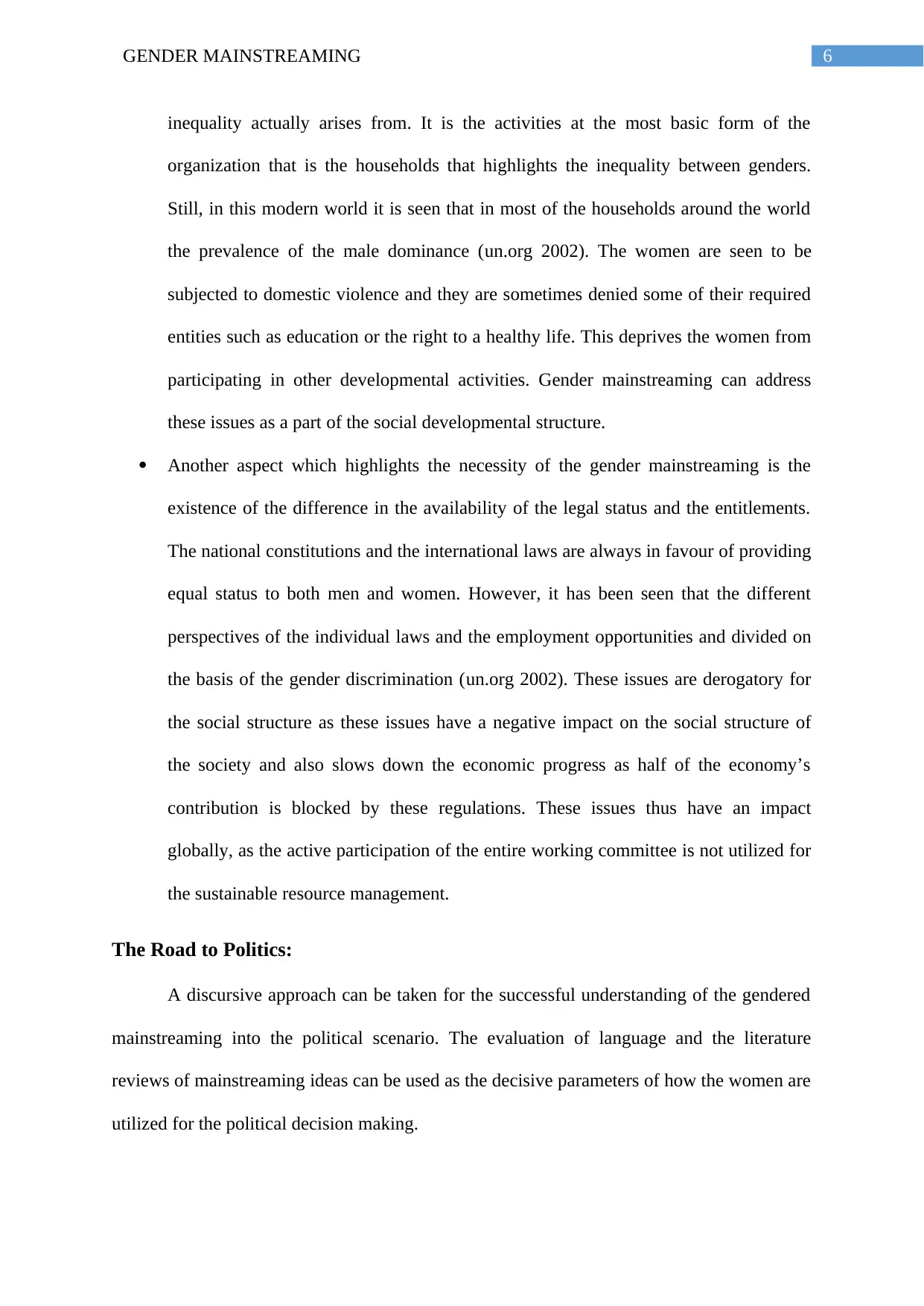
6GENDER MAINSTREAMING
inequality actually arises from. It is the activities at the most basic form of the
organization that is the households that highlights the inequality between genders.
Still, in this modern world it is seen that in most of the households around the world
the prevalence of the male dominance (un.org 2002). The women are seen to be
subjected to domestic violence and they are sometimes denied some of their required
entities such as education or the right to a healthy life. This deprives the women from
participating in other developmental activities. Gender mainstreaming can address
these issues as a part of the social developmental structure.
Another aspect which highlights the necessity of the gender mainstreaming is the
existence of the difference in the availability of the legal status and the entitlements.
The national constitutions and the international laws are always in favour of providing
equal status to both men and women. However, it has been seen that the different
perspectives of the individual laws and the employment opportunities and divided on
the basis of the gender discrimination (un.org 2002). These issues are derogatory for
the social structure as these issues have a negative impact on the social structure of
the society and also slows down the economic progress as half of the economy’s
contribution is blocked by these regulations. These issues thus have an impact
globally, as the active participation of the entire working committee is not utilized for
the sustainable resource management.
The Road to Politics:
A discursive approach can be taken for the successful understanding of the gendered
mainstreaming into the political scenario. The evaluation of language and the literature
reviews of mainstreaming ideas can be used as the decisive parameters of how the women are
utilized for the political decision making.
inequality actually arises from. It is the activities at the most basic form of the
organization that is the households that highlights the inequality between genders.
Still, in this modern world it is seen that in most of the households around the world
the prevalence of the male dominance (un.org 2002). The women are seen to be
subjected to domestic violence and they are sometimes denied some of their required
entities such as education or the right to a healthy life. This deprives the women from
participating in other developmental activities. Gender mainstreaming can address
these issues as a part of the social developmental structure.
Another aspect which highlights the necessity of the gender mainstreaming is the
existence of the difference in the availability of the legal status and the entitlements.
The national constitutions and the international laws are always in favour of providing
equal status to both men and women. However, it has been seen that the different
perspectives of the individual laws and the employment opportunities and divided on
the basis of the gender discrimination (un.org 2002). These issues are derogatory for
the social structure as these issues have a negative impact on the social structure of
the society and also slows down the economic progress as half of the economy’s
contribution is blocked by these regulations. These issues thus have an impact
globally, as the active participation of the entire working committee is not utilized for
the sustainable resource management.
The Road to Politics:
A discursive approach can be taken for the successful understanding of the gendered
mainstreaming into the political scenario. The evaluation of language and the literature
reviews of mainstreaming ideas can be used as the decisive parameters of how the women are
utilized for the political decision making.
Paraphrase This Document
Need a fresh take? Get an instant paraphrase of this document with our AI Paraphraser
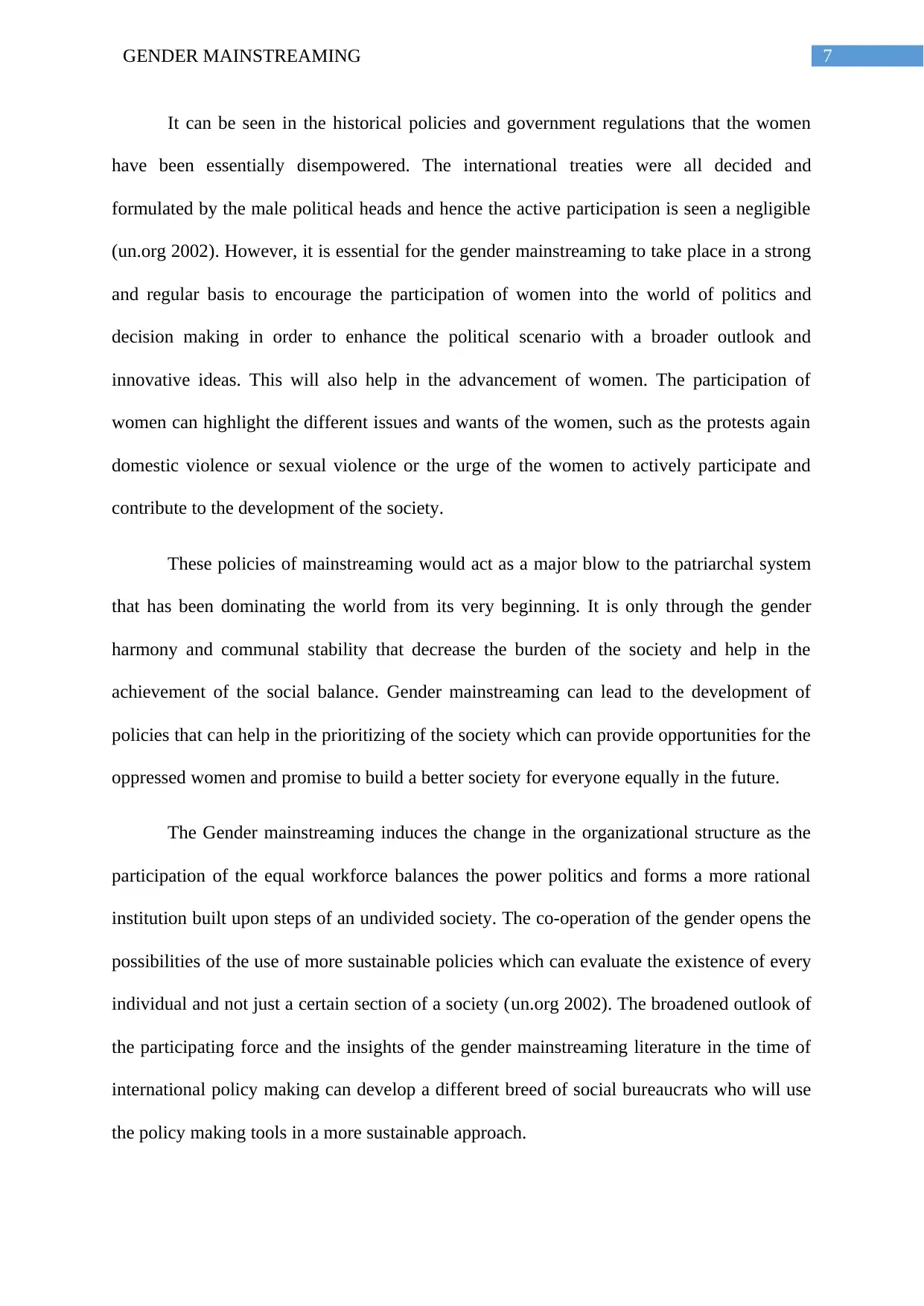
7GENDER MAINSTREAMING
It can be seen in the historical policies and government regulations that the women
have been essentially disempowered. The international treaties were all decided and
formulated by the male political heads and hence the active participation is seen a negligible
(un.org 2002). However, it is essential for the gender mainstreaming to take place in a strong
and regular basis to encourage the participation of women into the world of politics and
decision making in order to enhance the political scenario with a broader outlook and
innovative ideas. This will also help in the advancement of women. The participation of
women can highlight the different issues and wants of the women, such as the protests again
domestic violence or sexual violence or the urge of the women to actively participate and
contribute to the development of the society.
These policies of mainstreaming would act as a major blow to the patriarchal system
that has been dominating the world from its very beginning. It is only through the gender
harmony and communal stability that decrease the burden of the society and help in the
achievement of the social balance. Gender mainstreaming can lead to the development of
policies that can help in the prioritizing of the society which can provide opportunities for the
oppressed women and promise to build a better society for everyone equally in the future.
The Gender mainstreaming induces the change in the organizational structure as the
participation of the equal workforce balances the power politics and forms a more rational
institution built upon steps of an undivided society. The co-operation of the gender opens the
possibilities of the use of more sustainable policies which can evaluate the existence of every
individual and not just a certain section of a society (un.org 2002). The broadened outlook of
the participating force and the insights of the gender mainstreaming literature in the time of
international policy making can develop a different breed of social bureaucrats who will use
the policy making tools in a more sustainable approach.
It can be seen in the historical policies and government regulations that the women
have been essentially disempowered. The international treaties were all decided and
formulated by the male political heads and hence the active participation is seen a negligible
(un.org 2002). However, it is essential for the gender mainstreaming to take place in a strong
and regular basis to encourage the participation of women into the world of politics and
decision making in order to enhance the political scenario with a broader outlook and
innovative ideas. This will also help in the advancement of women. The participation of
women can highlight the different issues and wants of the women, such as the protests again
domestic violence or sexual violence or the urge of the women to actively participate and
contribute to the development of the society.
These policies of mainstreaming would act as a major blow to the patriarchal system
that has been dominating the world from its very beginning. It is only through the gender
harmony and communal stability that decrease the burden of the society and help in the
achievement of the social balance. Gender mainstreaming can lead to the development of
policies that can help in the prioritizing of the society which can provide opportunities for the
oppressed women and promise to build a better society for everyone equally in the future.
The Gender mainstreaming induces the change in the organizational structure as the
participation of the equal workforce balances the power politics and forms a more rational
institution built upon steps of an undivided society. The co-operation of the gender opens the
possibilities of the use of more sustainable policies which can evaluate the existence of every
individual and not just a certain section of a society (un.org 2002). The broadened outlook of
the participating force and the insights of the gender mainstreaming literature in the time of
international policy making can develop a different breed of social bureaucrats who will use
the policy making tools in a more sustainable approach.
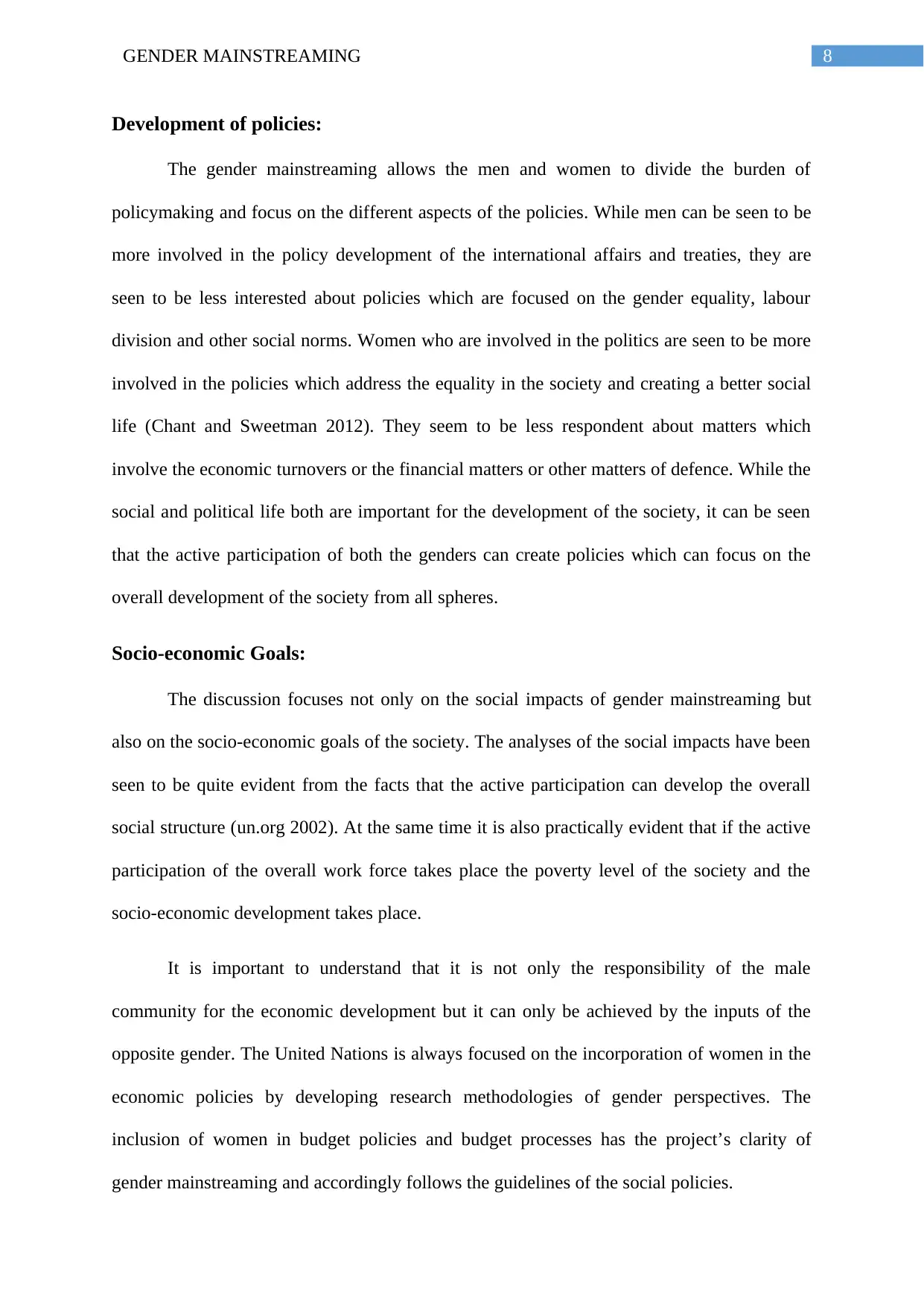
8GENDER MAINSTREAMING
Development of policies:
The gender mainstreaming allows the men and women to divide the burden of
policymaking and focus on the different aspects of the policies. While men can be seen to be
more involved in the policy development of the international affairs and treaties, they are
seen to be less interested about policies which are focused on the gender equality, labour
division and other social norms. Women who are involved in the politics are seen to be more
involved in the policies which address the equality in the society and creating a better social
life (Chant and Sweetman 2012). They seem to be less respondent about matters which
involve the economic turnovers or the financial matters or other matters of defence. While the
social and political life both are important for the development of the society, it can be seen
that the active participation of both the genders can create policies which can focus on the
overall development of the society from all spheres.
Socio-economic Goals:
The discussion focuses not only on the social impacts of gender mainstreaming but
also on the socio-economic goals of the society. The analyses of the social impacts have been
seen to be quite evident from the facts that the active participation can develop the overall
social structure (un.org 2002). At the same time it is also practically evident that if the active
participation of the overall work force takes place the poverty level of the society and the
socio-economic development takes place.
It is important to understand that it is not only the responsibility of the male
community for the economic development but it can only be achieved by the inputs of the
opposite gender. The United Nations is always focused on the incorporation of women in the
economic policies by developing research methodologies of gender perspectives. The
inclusion of women in budget policies and budget processes has the project’s clarity of
gender mainstreaming and accordingly follows the guidelines of the social policies.
Development of policies:
The gender mainstreaming allows the men and women to divide the burden of
policymaking and focus on the different aspects of the policies. While men can be seen to be
more involved in the policy development of the international affairs and treaties, they are
seen to be less interested about policies which are focused on the gender equality, labour
division and other social norms. Women who are involved in the politics are seen to be more
involved in the policies which address the equality in the society and creating a better social
life (Chant and Sweetman 2012). They seem to be less respondent about matters which
involve the economic turnovers or the financial matters or other matters of defence. While the
social and political life both are important for the development of the society, it can be seen
that the active participation of both the genders can create policies which can focus on the
overall development of the society from all spheres.
Socio-economic Goals:
The discussion focuses not only on the social impacts of gender mainstreaming but
also on the socio-economic goals of the society. The analyses of the social impacts have been
seen to be quite evident from the facts that the active participation can develop the overall
social structure (un.org 2002). At the same time it is also practically evident that if the active
participation of the overall work force takes place the poverty level of the society and the
socio-economic development takes place.
It is important to understand that it is not only the responsibility of the male
community for the economic development but it can only be achieved by the inputs of the
opposite gender. The United Nations is always focused on the incorporation of women in the
economic policies by developing research methodologies of gender perspectives. The
inclusion of women in budget policies and budget processes has the project’s clarity of
gender mainstreaming and accordingly follows the guidelines of the social policies.
⊘ This is a preview!⊘
Do you want full access?
Subscribe today to unlock all pages.

Trusted by 1+ million students worldwide
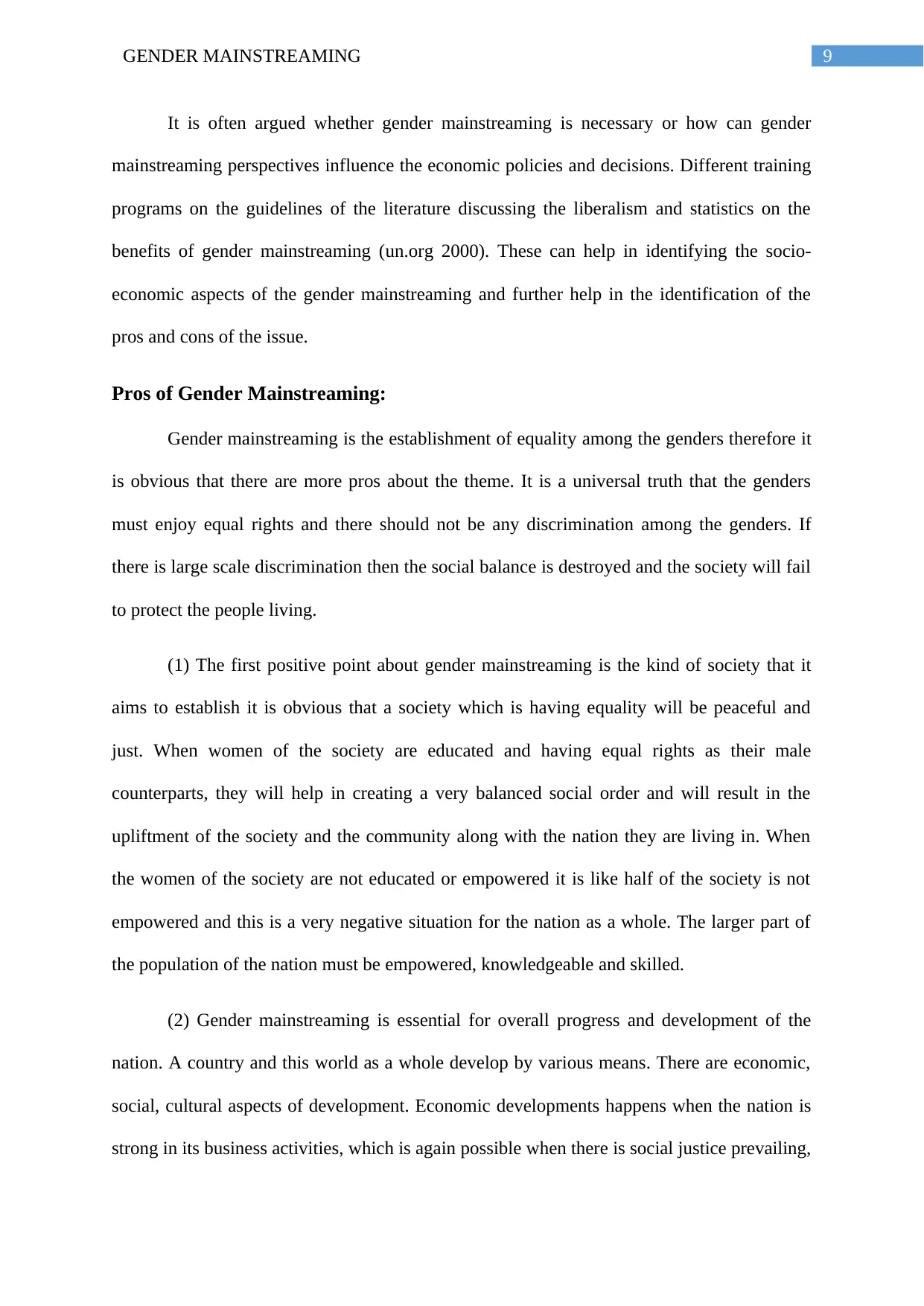
9GENDER MAINSTREAMING
It is often argued whether gender mainstreaming is necessary or how can gender
mainstreaming perspectives influence the economic policies and decisions. Different training
programs on the guidelines of the literature discussing the liberalism and statistics on the
benefits of gender mainstreaming (un.org 2000). These can help in identifying the socio-
economic aspects of the gender mainstreaming and further help in the identification of the
pros and cons of the issue.
Pros of Gender Mainstreaming:
Gender mainstreaming is the establishment of equality among the genders therefore it
is obvious that there are more pros about the theme. It is a universal truth that the genders
must enjoy equal rights and there should not be any discrimination among the genders. If
there is large scale discrimination then the social balance is destroyed and the society will fail
to protect the people living.
(1) The first positive point about gender mainstreaming is the kind of society that it
aims to establish it is obvious that a society which is having equality will be peaceful and
just. When women of the society are educated and having equal rights as their male
counterparts, they will help in creating a very balanced social order and will result in the
upliftment of the society and the community along with the nation they are living in. When
the women of the society are not educated or empowered it is like half of the society is not
empowered and this is a very negative situation for the nation as a whole. The larger part of
the population of the nation must be empowered, knowledgeable and skilled.
(2) Gender mainstreaming is essential for overall progress and development of the
nation. A country and this world as a whole develop by various means. There are economic,
social, cultural aspects of development. Economic developments happens when the nation is
strong in its business activities, which is again possible when there is social justice prevailing,
It is often argued whether gender mainstreaming is necessary or how can gender
mainstreaming perspectives influence the economic policies and decisions. Different training
programs on the guidelines of the literature discussing the liberalism and statistics on the
benefits of gender mainstreaming (un.org 2000). These can help in identifying the socio-
economic aspects of the gender mainstreaming and further help in the identification of the
pros and cons of the issue.
Pros of Gender Mainstreaming:
Gender mainstreaming is the establishment of equality among the genders therefore it
is obvious that there are more pros about the theme. It is a universal truth that the genders
must enjoy equal rights and there should not be any discrimination among the genders. If
there is large scale discrimination then the social balance is destroyed and the society will fail
to protect the people living.
(1) The first positive point about gender mainstreaming is the kind of society that it
aims to establish it is obvious that a society which is having equality will be peaceful and
just. When women of the society are educated and having equal rights as their male
counterparts, they will help in creating a very balanced social order and will result in the
upliftment of the society and the community along with the nation they are living in. When
the women of the society are not educated or empowered it is like half of the society is not
empowered and this is a very negative situation for the nation as a whole. The larger part of
the population of the nation must be empowered, knowledgeable and skilled.
(2) Gender mainstreaming is essential for overall progress and development of the
nation. A country and this world as a whole develop by various means. There are economic,
social, cultural aspects of development. Economic developments happens when the nation is
strong in its business activities, which is again possible when there is social justice prevailing,
Paraphrase This Document
Need a fresh take? Get an instant paraphrase of this document with our AI Paraphraser
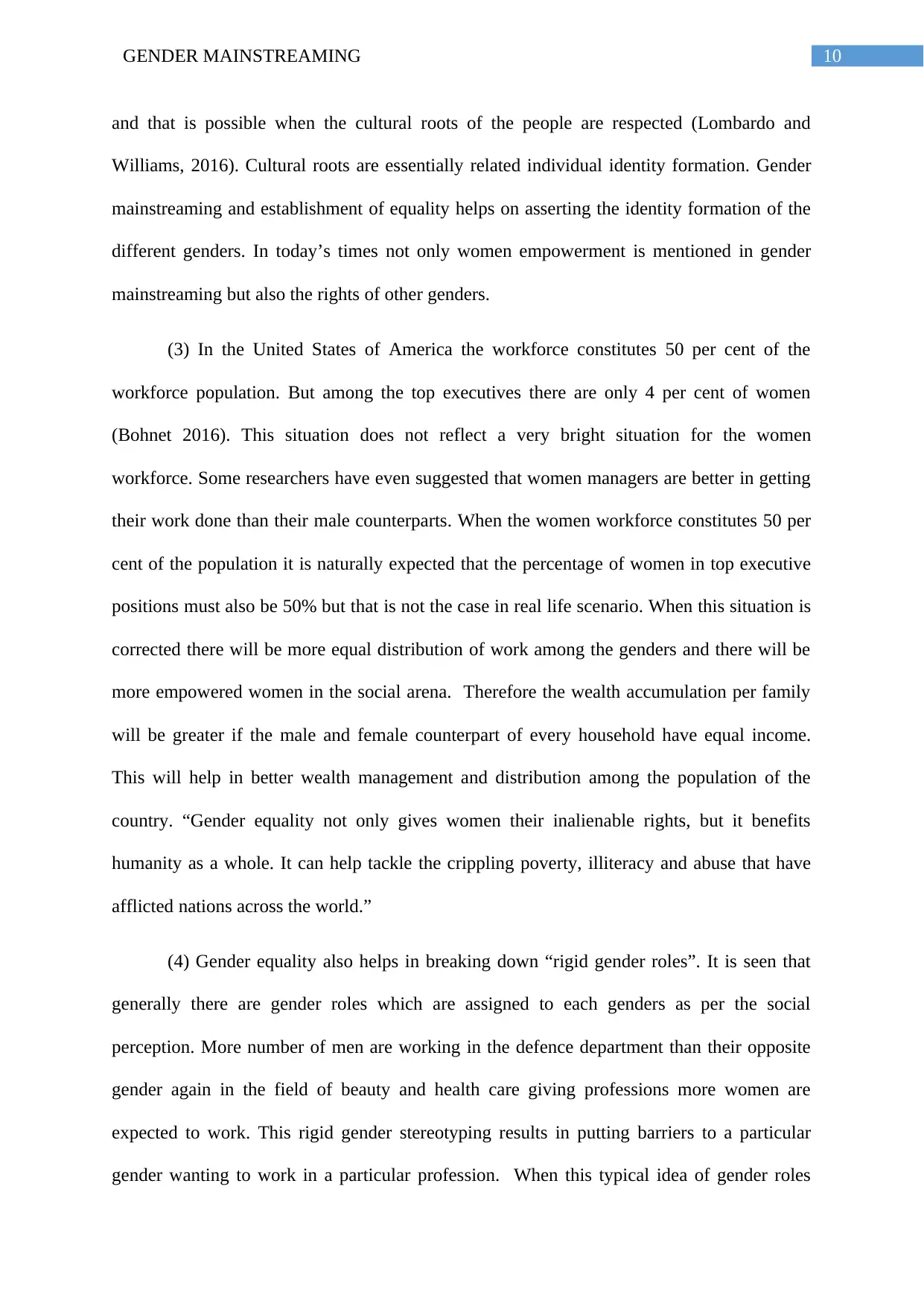
10GENDER MAINSTREAMING
and that is possible when the cultural roots of the people are respected (Lombardo and
Williams, 2016). Cultural roots are essentially related individual identity formation. Gender
mainstreaming and establishment of equality helps on asserting the identity formation of the
different genders. In today’s times not only women empowerment is mentioned in gender
mainstreaming but also the rights of other genders.
(3) In the United States of America the workforce constitutes 50 per cent of the
workforce population. But among the top executives there are only 4 per cent of women
(Bohnet 2016). This situation does not reflect a very bright situation for the women
workforce. Some researchers have even suggested that women managers are better in getting
their work done than their male counterparts. When the women workforce constitutes 50 per
cent of the population it is naturally expected that the percentage of women in top executive
positions must also be 50% but that is not the case in real life scenario. When this situation is
corrected there will be more equal distribution of work among the genders and there will be
more empowered women in the social arena. Therefore the wealth accumulation per family
will be greater if the male and female counterpart of every household have equal income.
This will help in better wealth management and distribution among the population of the
country. “Gender equality not only gives women their inalienable rights, but it benefits
humanity as a whole. It can help tackle the crippling poverty, illiteracy and abuse that have
afflicted nations across the world.”
(4) Gender equality also helps in breaking down “rigid gender roles”. It is seen that
generally there are gender roles which are assigned to each genders as per the social
perception. More number of men are working in the defence department than their opposite
gender again in the field of beauty and health care giving professions more women are
expected to work. This rigid gender stereotyping results in putting barriers to a particular
gender wanting to work in a particular profession. When this typical idea of gender roles
and that is possible when the cultural roots of the people are respected (Lombardo and
Williams, 2016). Cultural roots are essentially related individual identity formation. Gender
mainstreaming and establishment of equality helps on asserting the identity formation of the
different genders. In today’s times not only women empowerment is mentioned in gender
mainstreaming but also the rights of other genders.
(3) In the United States of America the workforce constitutes 50 per cent of the
workforce population. But among the top executives there are only 4 per cent of women
(Bohnet 2016). This situation does not reflect a very bright situation for the women
workforce. Some researchers have even suggested that women managers are better in getting
their work done than their male counterparts. When the women workforce constitutes 50 per
cent of the population it is naturally expected that the percentage of women in top executive
positions must also be 50% but that is not the case in real life scenario. When this situation is
corrected there will be more equal distribution of work among the genders and there will be
more empowered women in the social arena. Therefore the wealth accumulation per family
will be greater if the male and female counterpart of every household have equal income.
This will help in better wealth management and distribution among the population of the
country. “Gender equality not only gives women their inalienable rights, but it benefits
humanity as a whole. It can help tackle the crippling poverty, illiteracy and abuse that have
afflicted nations across the world.”
(4) Gender equality also helps in breaking down “rigid gender roles”. It is seen that
generally there are gender roles which are assigned to each genders as per the social
perception. More number of men are working in the defence department than their opposite
gender again in the field of beauty and health care giving professions more women are
expected to work. This rigid gender stereotyping results in putting barriers to a particular
gender wanting to work in a particular profession. When this typical idea of gender roles
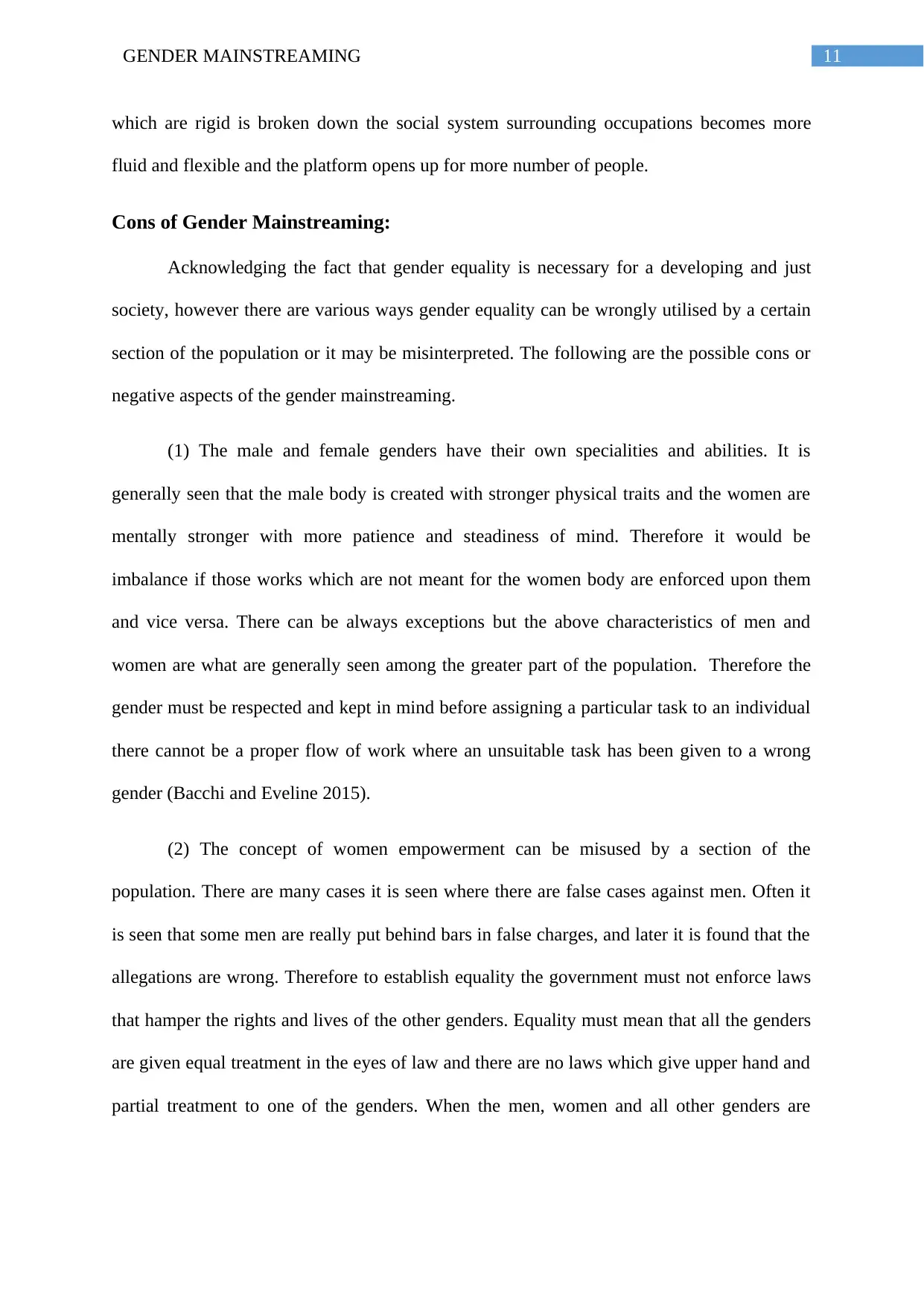
11GENDER MAINSTREAMING
which are rigid is broken down the social system surrounding occupations becomes more
fluid and flexible and the platform opens up for more number of people.
Cons of Gender Mainstreaming:
Acknowledging the fact that gender equality is necessary for a developing and just
society, however there are various ways gender equality can be wrongly utilised by a certain
section of the population or it may be misinterpreted. The following are the possible cons or
negative aspects of the gender mainstreaming.
(1) The male and female genders have their own specialities and abilities. It is
generally seen that the male body is created with stronger physical traits and the women are
mentally stronger with more patience and steadiness of mind. Therefore it would be
imbalance if those works which are not meant for the women body are enforced upon them
and vice versa. There can be always exceptions but the above characteristics of men and
women are what are generally seen among the greater part of the population. Therefore the
gender must be respected and kept in mind before assigning a particular task to an individual
there cannot be a proper flow of work where an unsuitable task has been given to a wrong
gender (Bacchi and Eveline 2015).
(2) The concept of women empowerment can be misused by a section of the
population. There are many cases it is seen where there are false cases against men. Often it
is seen that some men are really put behind bars in false charges, and later it is found that the
allegations are wrong. Therefore to establish equality the government must not enforce laws
that hamper the rights and lives of the other genders. Equality must mean that all the genders
are given equal treatment in the eyes of law and there are no laws which give upper hand and
partial treatment to one of the genders. When the men, women and all other genders are
which are rigid is broken down the social system surrounding occupations becomes more
fluid and flexible and the platform opens up for more number of people.
Cons of Gender Mainstreaming:
Acknowledging the fact that gender equality is necessary for a developing and just
society, however there are various ways gender equality can be wrongly utilised by a certain
section of the population or it may be misinterpreted. The following are the possible cons or
negative aspects of the gender mainstreaming.
(1) The male and female genders have their own specialities and abilities. It is
generally seen that the male body is created with stronger physical traits and the women are
mentally stronger with more patience and steadiness of mind. Therefore it would be
imbalance if those works which are not meant for the women body are enforced upon them
and vice versa. There can be always exceptions but the above characteristics of men and
women are what are generally seen among the greater part of the population. Therefore the
gender must be respected and kept in mind before assigning a particular task to an individual
there cannot be a proper flow of work where an unsuitable task has been given to a wrong
gender (Bacchi and Eveline 2015).
(2) The concept of women empowerment can be misused by a section of the
population. There are many cases it is seen where there are false cases against men. Often it
is seen that some men are really put behind bars in false charges, and later it is found that the
allegations are wrong. Therefore to establish equality the government must not enforce laws
that hamper the rights and lives of the other genders. Equality must mean that all the genders
are given equal treatment in the eyes of law and there are no laws which give upper hand and
partial treatment to one of the genders. When the men, women and all other genders are
⊘ This is a preview!⊘
Do you want full access?
Subscribe today to unlock all pages.

Trusted by 1+ million students worldwide
1 out of 20
Related Documents
Your All-in-One AI-Powered Toolkit for Academic Success.
+13062052269
info@desklib.com
Available 24*7 on WhatsApp / Email
![[object Object]](/_next/static/media/star-bottom.7253800d.svg)
Unlock your academic potential
Copyright © 2020–2025 A2Z Services. All Rights Reserved. Developed and managed by ZUCOL.





